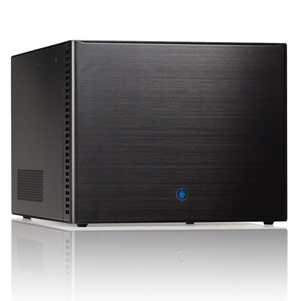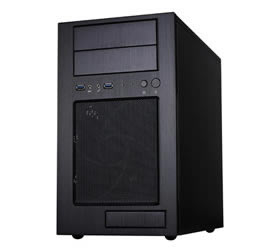File Server Builder's Guide
by Zach Throckmorton on September 4, 2011 3:30 PM ESTAs motherboard layout is important in ensuring that airflow is as unobstructed as possible, case design is also critical in facilitating excellent airflow. If you're building a system with one or two hard drives, most cases work fine for a home file server - just make sure there is a fan near the hard drive(s) so it is not sitting in stagnant air. However, if your server requires multiple disks, here are a few cases that work especially well for file servers.
Mini-ITX

Fractal's Array R2 is a nearly perfect home file server case. At less than 14" deep by 10" wide by 8" tall, it occupies little volume. It positions a removable hard drive cage immediately behind a quiet yet powerful 140mm intake fan. The hard drive cage accommodates up to six hard drives using vibration-dampening silicone mounts, and there is also room for a 2.5" drive (either an SSD or HDD). According to my testing, when stuffed with six low-rpm 2TB mass storage HDDs and one SSD (with an Intel Pentium G620 CPU installed), the temperatures of the HDDs hover around 40C even when all drives are under artificial sustained load (using Iometer). The PSU is a custom SFX form factor model, 80+ efficiency 300W unit with ample amps on the split 12V rail to power six HDDs. The PSU features seven SATA connectors and one legacy molex connector, so there are no extraneous molex plugs and enough SATA plugs. Furthermore, the cables are shorter than typical, so excessive cabling does not interfere with airflow. The case itself is constructed of aluminum so it is lightweight, and its overall build quality is very high. It does not have room for an optical drive, but I consider optical drives superfluous for a home file server. If necessary, you can always hook up a USB interface external optical drive. The only drawback of this case and its PSU is the price: at just under $200, it is not cheap. However, the subjective aesthetics, objective functionality of the case and the custom PSU are worth the cost if you want a small but capacious home file server case.
Micro-ATX

As I prefer home file servers that take up as little space as possible, Silverstone's TJ08B-E is a great, smaller micro-ATX minitower. It's less than 16" deep, 9" wide, 15" tall and weighs less than 12 pounds. It can accommodate up to five HDDs plus one SSD. As with the Fractal Array R2, the hard drives are placed immediately behind a front intake fan - though in this case, it's an even larger 180mm unit. The TJ08B-E is flexible in that it can hold a couple optical drives as well as a GPU in case you want to repurpose or multipurpose it. When stuffed with four low-rpm green drives, the temperatures under load don't exceed 45C during sustained transfers. Overall build quality is very good, like most Silverstone cases.
Silverstone makes a diminutive, fully modular PSU that makes working with smaller cases like the TJ08B-E, Lian Li PC-Q08, and others much easier. Silverstone also offers a short cable kit, making the ST50F-P PSU even better suited to SFF cases. Finally, it's clear that Silverstone had smaller multi-HDD systems in mind when designing the CP06 SATA power plug extension cable. This extender connects to a single SATA power plug and then has four SATA power plugs that are spaced closer than usual together, further reducing cable clutter. Though the cost of these accessories adds up, they make an ideal cabling solution very easy to implement. Regardless of whatever PSU you decide to go with, if you use a split 12V rail model, make sure you don't load up one rail with HDDs. If you go with a single 12V rail model, you'll want that rail to be beefy - for example, don't try to put ten HDDs and four case fans on a budget PSU with a 20A 12V rail.
Full Tower
Very few cases can accommodate ten HDDs at stock (without adding adapters), and such cases are not at all small. Full towers also typically offer excellent airflow, and cable management is not very difficult. Fractal's Define XL is one of the least expensive 10 HDD bay full tower cases available. It is well-built, and extra care has been paid to making the case quiet in the form of panel insulation. It is impossible to hear active HDDs inside this case even when you're sitting just a few feet from it (even the notoriously loud VelociRaptors). Further, there are plenty of integrated niceties like adjustable/flexible cable baffles that assist in cable management. Seven of the ten HDD slots are immediately behind fans, with three slots one cage removed from the front intake fans. Even still, the HDDs that aren't right behind the fans stay cool (between 35C and 40C). At around $150, it is an excellent value. Just make sure you don't pair it up with Silverstone's short cable kit!
We've saved the most important aspect of a home file server - the hard drives - for the next and last component page.











152 Comments
View All Comments
TheeVagabond - Thursday, September 29, 2011 - link
Seriously, people's responses... like they must be rolling in the money. Overkill much, what kind of home data do people have.DanNeely - Sunday, September 4, 2011 - link
With the cheapest 10GB nic's on newegg being almost $500 each it's still far too expensive for the typical home network. You'd also probably want a significantly more powerul system than what was described in the article. Feeding a 10GB NIC generally eats an entire core of a XEON chip.JohanAnandtech - Monday, September 5, 2011 - link
Our measurement show that a 10GB NIC needs even more than one core. 14% of 12 2 GHz Xeon cores, that is about 3.4 GHz of Xeon power.http://www.anandtech.com/show/4014/10g-more-than-a...
Described in desktop terms, that means that you need at least one of Core I5 2400 system just to power your 10G cards. And you probably need more.
DanNeely - Monday, September 5, 2011 - link
Ooops. Guess i skimmed that article too fast; didn't realize it was a hex-core chip.DanNeely - Sunday, September 4, 2011 - link
10c/kwh is roughly $1/wattyear, so it'd only take around a year for the lower powered Intel box to save more than the AMD equivalent.yottabit42 - Sunday, September 4, 2011 - link
No mention of OpenFiler as a NAS distribution?It's based on a funky, little-known Linux distribution, but I found it much easier to setup and more advanced than FreeNAS. I've been using it for years to host 10 TB of RAID-5 storage and 2 TB of RAID-6 storage, served via FTP, Samba, and rsync. Both arrays are soft-RAID, too. Virtually no problems ever, even with frequent power outages and using XFS as the filesystem (prone to corruption with power outages due to high degree of caching).
HMTK - Monday, September 5, 2011 - link
Yep. I also like OpenFiler. Easy to set up NFS and iSCSI if that's your thing.whaler_99 - Sunday, September 4, 2011 - link
I am surprised as you mention WHS and FreeNas, as well as drop the Drobo and such name around, that you did not look at unRAID. This is a solution a lot of us are turning to - a basic system license is free, and a 20 drive data system with parity and cache runs you $150 for the license. And can run on pretty much whatever you have laying around. You can start small and grow big. Definately worth a look.jnmfox - Sunday, September 4, 2011 - link
+1000unRAID is easy to use has great community support and like was mentioned is free and can be put on leftover hardware. For basic media storage it is one of the best options for a file server. unRAID doesn't have the limitations of RAID, you can use any combination of HDs and add more as needed, data is protected via the parity drive so you don't have data duplication giving you more HD space.
3DoubleD - Monday, September 5, 2011 - link
+ another 1000Unraid is awesome. It is a shame that it was left out of this review. It has to be one of the most flexible solutions out there. It is super easy to use, yet offers an unlimited amount of customization. The community support is fantastic as well.
As far as DIY home storage server software goes, I think it's the best around.